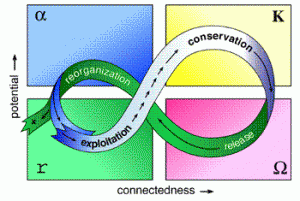
Managing for stability just doesn’t work.
This epiphany has helped forge the development of ecosystem based management (EBM), theoretically a more holistic approach to natural resource management that is more in tune with natural processes. However, we still haven’t worked out the kinks so something good in theory often falls flat. A couple of recent papers in Conservation Biology discuss the need for measureable endpoints in EBM in order for the plan to be successful. But first, a little background.
There is a slow awakening among management agencies that stability policies aren’t effective – in fact, they often produce the opposite of the desired effect. Need examples as proof? Fire suppression to maintain healthy forest growth promoted through the middle part of the last century is now understood to provide a century’s worth of fuel when natural fires do occur. Such a process was behind the fires that lit the night skies over much of California last summer. These fires even kill the trees that depend on fire for germination, leaving wide swaths of land starting from square one in recovery.
A more subtle example comes from the ocean in the form of fisheries management. Maximum sustainable yield, while the term sounds really nice, depends on complicated models to predict fish populations and doesn’t account for natural variability in ocean circulation, storm patterns, or population dynamics of predators or prey of the fishery species in question. Result? In years with lots of surprises like hurricanes, colder than usual summers, or slower upwelling, the fishers who stick to the MSY as a quota drastically overfish the system, which hasn’t conformed to the model. Whoops, someone forgot to tell the fish to behave.

Hopefully you’re convinced something else is needed. The classic diagram of the alternative, known as the adaptive cycle, was first described by Gunderson and Holling in their 2002 book Panarchy. Basically, an ecosystem (including human activity) begins in the exploitation phase, extracting resources like fish or wood. After a slow development of both the natural and social system in question, a more harmonious balance is struck, termed conservation. But all the regulation and organization bottles up a need for dynamism within the system and eventually there is catastrophic destruction, or release. The resources and people then reorganize, often under new leadership, to create a new system and begin the cycle again. Basically, nothing lasts forever and nature has a tendency to organize.
The important aspects of the system to maintain, then, aren’t the static needs at any one point in the cycle, but the processes that move the cycle along it’s natural path. It’s the idea behind ecosystem based management. Process is important, not result.

Two things of note in this model – there is no endpoint that can be easily measured and monitored and there is no overt priority for human needs in the system. Taking the forest fire example, the burn years are important for the overall system to maintain itself over centuries but if you’re living in the forest the year it’s supposed to burn, life is going to be hard for a little while. What can you point at here as successful management?
Gunderson and Holling warn readers in their original description that the model is designed for ecosystems, not necessarily human institutions. In fact, they make an explicit point that if you let their model become a model for everything, it is useful for nothing.
Granek et al take on the issue in a recent issue of Conservation Biology, proposing ecosystem services as the needed
“common language” to evaluate EBM approaches. They emphasize “a clear mandate to sustain the delivery of ecosystem services and a framework for quantifying trade-offs among them can provide a foundation for coordinated management”.
Quantification of ecosystem services, however, requires interdisciplinary collaboration to combine economic, biogeochemical, ecologic, and social variables into one comparable model. They are representations of ecosystem process and function from an anthropocentric policy perspective, but likely are relevant for stakeholders in any one given area. Granek et al cite the use of the ecosystem service concept gaining traction in management of the Gulf of Mexico hypoxic zone, a downstream system requiring collaboration of many land and water uses to maintain any use at all.
Granek et al also acknowledge there are still major challenges in the ecosystem service concept itself that must be solved before utilization by another management system. First, that the quantification process will become another bureaucratic process easily captured by special interests. Second, that services are often hard to quantify in a standard measure, usually monetary, without shortchanging more abstract values. So it may be still to early to employ the concept at a large policy scale.

Peterson et al in the same issue of Conservation Biology also caution that the terms ecosystem function and ecosystem services may be confounded. Although Granek et al specifically said they were using services as a proxy for function, Peterson’s article brings up a valid point that policymakers and the public at large may not understand the nuanced difference between the two. Use of services is a value-laden decision to prioritize current human uses of a system. Other important functions of the system or future human uses are not included in the quantification.
According to Peterson’s critique, “ecosystem workers” are much like Marx’s proletariat, undervalued and commodified. They recognize the need for some quantifiable measurement of management success but offer that “explicitly presenting ecosystem services as discreet and incomplete aspects of ecosystem functions not only allows potential economic and environmental benefits associated with ecosystem services, but also enables the social and political changes required to ensure valuation of ecosystem functions and related biodiversity in ways beyond their measurement on an economic scale”
So the challenge is still out there for a target of management and a metric by which management can be evaluated and revised.
~ Bluegrass Blue Crab
References:
GRANEK, E., POLASKY, S., KAPPEL, C., REED, D., STOMS, D., KOCH, E., KENNEDY, C., CRAMER, L., HACKER, S., BARBIER, E., ASWANI, S., RUCKELSHAUS, M., PERILLO, G., SILLIMAN, B., MUTHIGA, N., BAEL, D., & WOLANSKI, E. (2010). Ecosystem Services as a Common Language for Coastal Ecosystem-Based Management Conservation Biology, 24 (1), 207-216 DOI: 10.1111/j.1523-1739.2009.01355.x
PETERSON, M., HALL, D., FELDPAUSCH-PARKER, A., & PETERSON, T. (2010). Obscuring Ecosystem Function with Application of the Ecosystem Services Concept Conservation Biology, 24 (1), 113-119 DOI: 10.1111/j.1523-1739.2009.01305.x

As it happens, I’m participating in a debate on ecosystem-based management on Thursday for my fisheries class. I have to argue that it’s a bad idea and we shouldn’t do it.
Any suggestions on how to do that, since it’s the exact opposite of my beliefs?
Well in short my top three:
1) People only “implement” it because there’s a significant financial incentive from the Packard Foundation to do so.
2) There’s absolutely no way to only protect ecosystem process (the basis of EBM) and still meet the demands of a resource extractive society. We have some serious social changes ahead of us before EBM can fit in with the norms.
3) EBM is still largely driven by classic ecology, often prioritizing the “ecosystem” or “wilderness” sans humans. That’s just not realistic on an ecosystem level. We’re not talking about a single park or preserve here, but whole watersheds.
And finally, there is yet to be a single successful application of the EBM concept.
You continue to rock.
“EBM is still largely driven by classic ecology, often prioritizing the “ecosystem” or “wilderness” sans humans.”
“And finally, there is yet to be a single successful application of the EBM concept.”
being on the implementing side of a comprehensive terrestrial and marine ebm project (in partnership with wcs and an entire district of 10 villages in fiji for the past 6 years) and documenting strong return on marine ecosystem function while incorporating and accommodating human needs for development and financial benefit-sharing along the way, you’ll understand if i’m skeptical of these conclusions…
Since I know you were all waiting with baited breath, I can report that our debate was a tie. The instructor assigned an even number of judges.
Rick, I’m really interested in this sort of thing (and not just because it was homework for this week’s fisheries class). Can you tell us more about your project?
there have been a few papers published–and lots of project content on either the coral reef alliance (CORAL) or wildlife conservation society (WCS) websites… but here’s a relatively recent case study produced by wcs (one of the co-authors is also a CORAL fiji field rep) that describes our fiji project…
http://tinyurl.com/y9bf6cy
don’t get me wrong, i do agree with amy’s premise that MOST ebm implementation takes a heavily ecological approach and tends to forget the human dimension… but fiji’s ebm has married resource management needs and community needs from the start…
Ok, so I may have been a bit inflammatory on purpose to get some discussion started (and it worked).
One of my labmates is actually studying fiji’s project from a social science perspective right now, and I’ll have to ask her more specifically, but the feeling I’ve gathered from the stories is that context before EBM came as a concept is a big part of the story. If community needs are very overtly a priority before any sort of new management steps in, then it will remain so as part of that new management. I’d argue that’s key to the success of EBM in Fiji and Palau.
Also a key part of the story of EBM in a developing world context is that the people are still resource dependent. According to Begossi, Palsson, Neis and others that I can’t think of off the top of my head, this is a necessary link between social and natural systems in order for EBM to work (to tie ecological and community goals).
And for that matter, necessary for the “socioecological system” to be resilient. Does that mean, as the developing nations of the south pacific decide to advance their place in global society that they give up a working resource management system?
As a retired scientist from the Fisheries Lab in Woods Hole, Ma., I feel that it is too early to tell whether adaptive, ecosystems-based management approaches are the answer to the problems faced by marine living marine, protected and natural trust resources. State/Federal agencies that manage these resources are organized along the lines of their legislative mandates, so that sustainable fisheries and the conservation/protection of marine mammals, sea turtles, and seabirds are handled by separate management processes that are poorly integrated and have different constituents.
This problem is exacerbated by the exclusion of fisheries management/regulation from most state/federal ocean marine spatial planning processes. The emerging plans to develop large scale renewable energy projects within the ocean will further complicate a more holistic approach for managing multiple human uses in the ocean commons, while at the same time protecting/restoring marine biota and their habitats.
A,EBM approaches are only one tool available to address a much wider array of problems (climate change, fisheries harvesting, invasive species, eutrophication, etc.). We need to develop a broader framework at a regional scale to integrate the activities of diverse regulatory agencies, constituent groups, multiple users of the ocean and the general public which owns public bottomlands and is concerned about the biota and their associated habitats.
The Federal ocean management approach proposes to do this through the Regional Ocean Councils. The Minerals Management Service has established separate state task forces for renewable energy projects, while fisheries regulation includes the regional fishery management councils. Having all of these separate regional management efforts is an unworkable approach for developing a holistic, ecosystem- based management system.
Similar problems plague state and inter-jurisdictional fisheries management efforts and coordinating these with state ocean planning efforts. In the Massachusetts Ocean Management Plan even though fisheries regulation is excluded from the planning process, commercial fishing and saltwater angling are preferred human uses in state ocean act jurisdictional waters. This decision was made in spite of the fact that 40-45% of our federally managed fish stocks are either overfished or subject to overfishing. Only the deep sea red crab fishery has been certified as sustainable by the Marine Stewardship Council. I am sure that similar situations exist elsewhere along the Atlantic seaboard.